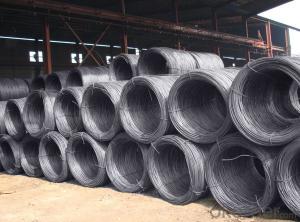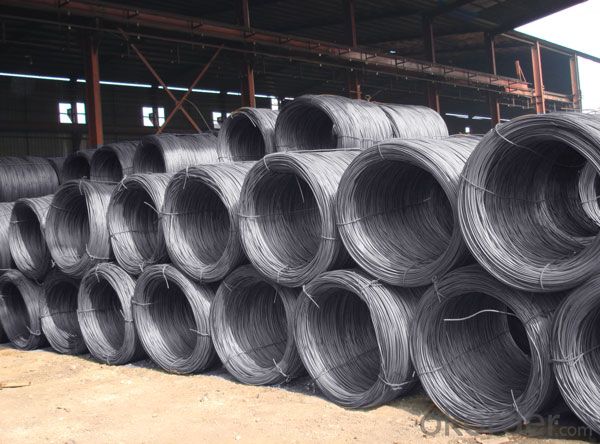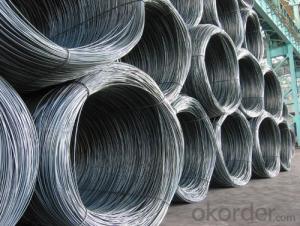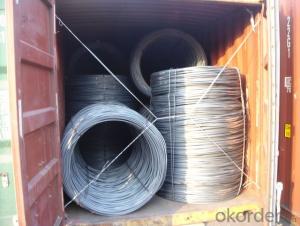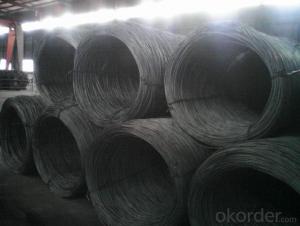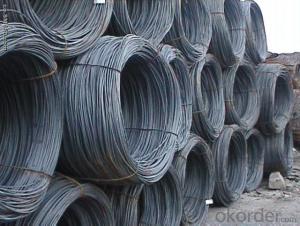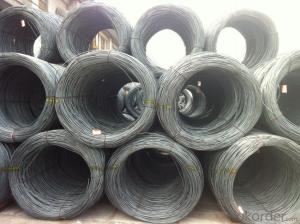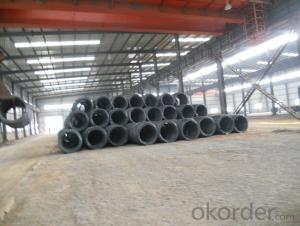hot rolled carbon steel wire rod Cold Heading Steel
- Loading Port:
- Tianjin
- Payment Terms:
- TT OR LC
- Min Order Qty:
- 30 m.t.
- Supply Capability:
- 45000 m.t./month
OKorder Service Pledge
Quality Product, Order Online Tracking, Timely Delivery
OKorder Financial Service
Credit Rating, Credit Services, Credit Purchasing
You Might Also Like
Packaging & Delivery
| Packaging Detail: | Packing: in coils, about 2 tons/coil or weight show each coil. shipment: in containers or by bulk |
| Delivery Detail: | 30 days |
Specifications
wire rod
1)Grade: Q195/235,SAE1006-1018B, H08A, 30MnSi , 62B-82B
2)Dia:5.5m-14mm
3)Price:$550-700 per ton
wire rod 1)Standard: Q195/235,SAE1006B/SAE1008B/SAE1010B/SAE1018B H08A, 30MnSi, 62B-82B 2)Dia:5.5mm-14mm 3)Packing: in coils 4)shipment: in containers or by bulk
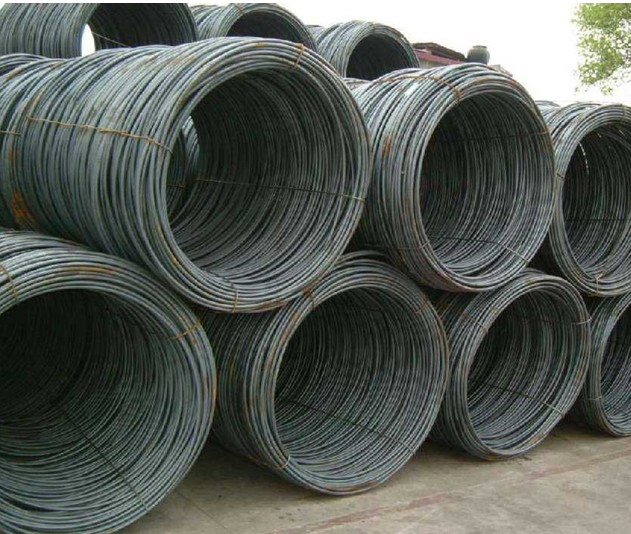

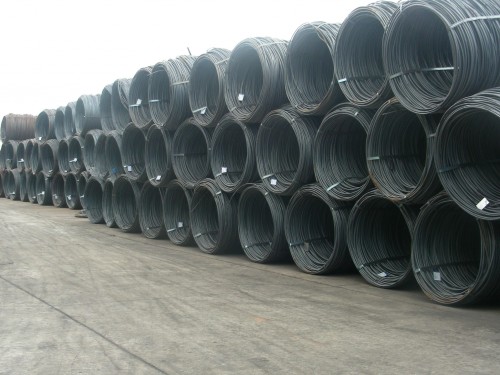
- Q: Can steel wire rod be used in high-temperature applications?
- Yes, steel wire rod can be used in high-temperature applications. Steel has excellent heat-resistant properties and can withstand high temperatures without losing its strength or structural integrity. However, the specific grade and composition of the steel wire rod should be considered to ensure it is suitable for the intended high-temperature environment.
- Q: What are the standard dimensional accuracy requirements for steel wire rod?
- The standard dimensional accuracy requirements for steel wire rod depend on the specific industry or application, as different industries may have their own set of standards and specifications. However, in general, steel wire rod is expected to meet certain dimensional tolerances, which typically include requirements for diameter, roundness, straightness, and surface quality. These tolerances ensure consistency and quality in the production and use of steel wire rod.
- Q: What are the common production processes for boron-coated steel wire rod?
- The common production processes for boron-coated steel wire rod include wire drawing, heat treatment, boron coating, and final inspection.
- Q: How is steel wire rod used in the manufacturing of wire for electrical heating cables?
- Steel wire rod is used in the manufacturing of wire for electrical heating cables as it serves as the base material for the wire. The steel wire rod is first drawn into the desired diameter and then coated with an insulating material, usually a thermoplastic or thermosetting polymer. This coated wire is then further processed and assembled with other components to form the electrical heating cable. The steel wire rod provides the necessary mechanical strength and stability to the wire, allowing it to withstand the high temperatures and electrical currents required for heating applications.
- Q: What are the main factors influencing the choice of steel wire rod manufacturer?
- There are several main factors that influence the choice of a steel wire rod manufacturer. These factors include: 1. Quality of the product: One of the primary factors influencing the choice of a steel wire rod manufacturer is the quality of the product they offer. Customers look for manufacturers that produce high-quality steel wire rods that meet their specific requirements and standards. This includes factors such as the strength, durability, and consistency of the wire rod. 2. Price: Price is another crucial factor that influences the choice of a steel wire rod manufacturer. Customers compare prices offered by different manufacturers and choose the one that provides the best value for money. However, it is important to consider the price in relation to the quality of the product and the overall service provided by the manufacturer. 3. Reliability and reputation: The reliability and reputation of a steel wire rod manufacturer play a significant role in the decision-making process. Customers prefer manufacturers with a proven track record of delivering high-quality products consistently and on time. Positive customer reviews, testimonials, and references from other trusted sources can greatly influence the choice of a manufacturer. 4. Production capacity and capabilities: The production capacity and capabilities of a steel wire rod manufacturer are important considerations for customers. Depending on their specific needs, customers may require a manufacturer that can produce large quantities of wire rods within a specified timeframe. Additionally, customers may also consider the manufacturer's ability to provide customized wire rod solutions or different variations of the product. 5. Technical expertise and support: Steel wire rod manufacturers with strong technical expertise and excellent customer support are often preferred by customers. Manufacturers that can provide technical guidance, assistance with product development, and after-sales support are seen as valuable partners in the steel wire rod purchasing process. 6. Environmental and sustainability practices: In recent years, environmental and sustainability practices have become increasingly important factors in the choice of a steel wire rod manufacturer. Customers look for manufacturers that prioritize sustainable production methods, minimize waste and emissions, and comply with environmental regulations. Overall, the main factors influencing the choice of a steel wire rod manufacturer are quality, price, reliability, production capacity, technical expertise, and environmental practices. Customers carefully evaluate these factors to ensure they select a manufacturer that can meet their specific requirements and provide a high-quality product and service.
- Q: What are the main factors influencing the choice of steel wire rod order lead time?
- The lead time for steel wire rod orders is determined by several key factors. Firstly, demand and supply dynamics have a significant impact. When there is high demand for steel wire rod products, manufacturers may experience longer lead times due to increased production requirements and limited availability of raw materials. Conversely, during periods of low demand, lead times may be shorter as manufacturers can allocate resources more efficiently. Another crucial factor is production capacity. The lead time depends on the manufacturer's production capacity. Limited production capacity can result in longer lead times, as it takes more time to fulfill orders. Conversely, manufacturers with larger production capacities can process orders more quickly, leading to shorter lead times. Transportation logistics also play a role in determining the lead time. If the manufacturer is far from the customer or faces logistical challenges, such as limited transportation options or customs clearance delays, the lead time may be longer. However, efficient transportation networks and streamlined logistics processes can help reduce lead times. Customer requirements are also considered when determining the lead time for steel wire rod orders. If customers have specific delivery deadlines or urgent requirements, manufacturers may prioritize these orders and provide shorter lead times to ensure customer satisfaction. On the other hand, if customers have flexible timelines, manufacturers may allocate resources to orders with shorter lead times. In conclusion, the choice of steel wire rod order lead time is influenced by demand and supply dynamics, production capacity, transportation logistics, and customer requirements. Manufacturers must carefully consider these factors to determine an appropriate lead time that meets customer needs while considering their operational capabilities.
- Q: How are steel wire rods used in the manufacturing of strings for musical instruments?
- Steel wire rods are used in the manufacturing of strings for musical instruments because of their high tensile strength and durability. These rods are first drawn into thin wires, which are then wound tightly together to form the core of the string. The core is then further wrapped with materials such as nickel, silver, or bronze to enhance the tone and playability of the string. The use of steel wire rods ensures that the strings have the necessary strength and flexibility to produce clear and resonant sound when played on musical instruments.
- Q: What are the common production processes for zinc-coated steel wire rod?
- The common production processes for zinc-coated steel wire rod include cleaning and pickling the steel wire rod, coating it with a layer of zinc through hot-dip galvanizing or electro-galvanizing, and finally, coiling the zinc-coated wire rod for packaging and transportation.
- Q: What are the different sizes and dimensions available for steel wire rod?
- Different industrial and commercial applications can be accommodated with a range of sizes and dimensions for steel wire rods. The typical diameter of steel wire rods ranges from 5.5mm to 20mm, depending on the intended use. Length options commonly include 6 meters or 12 meters, but customized lengths are also possible based on specific requirements. Steel wire rods are measured by weight per unit length, which can vary according to the diameter and density of the steel used. To suit various applications, steel wire rods are manufactured with different levels of tensile strength, ranging from 500 MPa to 1,200 MPa. Surface finishes, such as bright, black, or galvanized, can be chosen based on the intended use and environmental conditions. It is important to note that availability of specific sizes and dimensions may differ among manufacturers and suppliers. Therefore, it is advisable to consult a trusted supplier or manufacturer to ensure that the required size and dimension of steel wire rod are available for a particular application.
- Q: How does the ductility of steel wire rod vary with different heat treatment processes?
- The ductility of steel wire rod can vary with different heat treatment processes. Heat treatment processes such as annealing and tempering can improve the ductility of steel wire rod by reducing its hardness and increasing its flexibility. On the other hand, processes like quenching and martempering can decrease the ductility of steel wire rod by increasing its hardness and brittleness. Therefore, the specific heat treatment process chosen can significantly affect the ductility of steel wire rod.
Send your message to us
hot rolled carbon steel wire rod Cold Heading Steel
- Loading Port:
- Tianjin
- Payment Terms:
- TT OR LC
- Min Order Qty:
- 30 m.t.
- Supply Capability:
- 45000 m.t./month
OKorder Service Pledge
Quality Product, Order Online Tracking, Timely Delivery
OKorder Financial Service
Credit Rating, Credit Services, Credit Purchasing
Similar products
Hot products
Hot Searches
Related keywords
